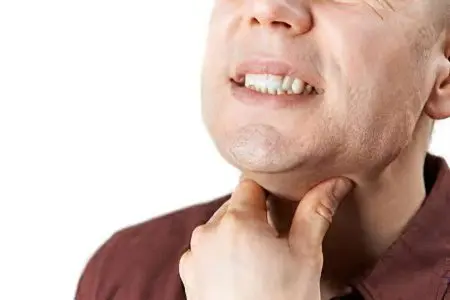Contents
Pain when swallowing – This is a symptom that can occur with various diseases of an infectious and non-infectious nature. Sometimes pain becomes the first sign of a cancerous growth, but this does not happen often. To understand what is the cause of the pain that occurs when swallowing, you need to contact the doctor for a diagnosis.
Causes of pain when swallowing

The main and most common cause of pain when swallowing is an acute respiratory infection caused by viruses. Slightly less often, bacteria lead to pain. In this case, a person is diagnosed with angina. Non-infectious causes can also cause pain.
Viruses that can cause pain when swallowing:
Influenza and parainfluenza viruses.
respiratory viruses.
measles virus.
The virus that causes chickenpox.
The virus that causes infectious mononucleosis.
Bacteria that can cause pain when swallowing:
Mycoplasmas.
Diphtheria stick.
Streptococci.
Chlamydia.
Gonococci
Other causes of pain when swallowing include:
Allergy. The reaction can occur to any irritants: dust, pollen, wool, food. In addition to painful swallowing movements, a person develops rhinitis, the conjunctiva of the eyes swells, and lacrimation increases.
Low humidity in the air that a person breathes. For this reason, the mucous membranes dry out, which leads to discomfort in the throat. This problem is especially relevant in winter, when central heating is working in the apartment. If, in addition to dry air, a person has problems with nasal breathing, then a sore throat will definitely occur.
Excessive tension in the muscles of the throat. A similar situation is observed with prolonged singing, with a cry, with a long conversation in raised tones.
Reflux esophagitis. In this disease, the contents of the stomach are thrown into the esophagus. Its walls are not adapted for contact with hydrochloric acid. Their irritation occurs, which leads to pain when swallowing.
HIV. The cause of pain when swallowing is reduced immunity. As a result of this pathology, the body cannot resist infection.
Cancerous tumors. If they are concentrated in the neck or esophagus, then the patient will have difficulty swallowing food. At risk are long-term smokers and people who abuse alcohol.
symptomatology

Pain when swallowing may be accompanied by other symptoms, which will depend on the cause that caused it.
If an inflammatory reaction occurs in the throat, then the signs of a violation will be as follows:
Hyperemia of the mucous membranes, sore throat.
Increased pain when eating hot drinks or foods.
Strengthening weakness.
Increased fatigue.
Headache.
Cough. At first it is dry, and then accompanied by sputum.
Types of pain
Depending on the symptoms that bother a person with pain when swallowing, a doctor can make a preliminary diagnosis. Clarify it with the help of additional surveys.
Sore throat when swallowing

The throat most often hurts in people with SARS. These colds are diagnosed in both children and adults.
Other causes of sore throat when swallowing include:
Throat abscess.
Injury received.
Ingestion of a foreign object in the throat.
Angina.
Diseases of the blood.
Osteochondrosis of the cervical spine. It is indicated by an increase in pain at the time of swallowing movements.
To understand the cause of the pain, the doctor will clarify some important points with the patient. He will be interested in the nature of the pain. It can be sharp, burning, pulsating, dull, pressing. Sometimes the pain occurs from time to time, and sometimes it is present on an ongoing basis.
It is important to tell the doctor exactly where the pain is concentrated: on the left, on the right, in the center, or cover the entire throat. Sometimes the pain occurs only during the daytime, and sometimes only at night. All these points are important for making an accurate diagnosis.
Lump or discomfort
A lump in the throat appears in patients with pharyngitis. With this disease, the throat becomes inflamed. Pharyngitis can be viral and bacterial in nature. Other symptoms include: cough, fever, muscle pain. If treatment is not started on time, then pharyngitis can turn into bronchitis or tonsillitis.
Read more: Lump in throat: how to get rid of?
On the one hand
Unilateral pain when swallowing occurs with infection. The most common cause is otitis media. Inflamed lymph nodes, streptococcal lesions of the tonsils, diphtheria, scarlet fever and measles can also lead to unilateral pain.
In the region of the Adam’s apple
Pain in the Adam’s apple occurs after an injury. It can be bruises, falls, sports injuries. In such situations, the risk of cartilage fracture increases, which causes pain. During a cough, a person may exude blood, sometimes a loud crunch is heard. Severe injury may result in suffocation.
Pain in the region of the Adam’s apple is characteristic of laryngitis. This disease is caused by viruses or bacteria. Sometimes laryngitis develops against the background of an overstrain of the vocal cords and when exposed to chemicals in this area.
stabbing
Stitching pain in the throat appears when foreign sharp objects get into it. It can be fish bones, poorly chewed food, pieces of fruit, shells of cereals. If a foreign object is not removed from the throat, then the pain will intensify. A person develops a chronic cough, choking may develop.
Gives in the ear
If the pain during swallowing gives to the ear, then inflammation of its tissues can be suspected. In addition to pain, purulent discharge appears, body temperature rises. The general condition worsens, there is no appetite.
Pain in the esophagus when swallowing
Esophagitis is the main cause of pain in the esophagus when swallowing. The disease can be caused by the herpes virus, or candida. Most often, pathology develops in people with reduced immunity.
The person suffers from chest pain, from dysphagia. A severe form of esophagitis is accompanied by nausea and vomiting, fever, chills. In the blood test, an increase in the level of leukocytes occurs. When infected with the herpes virus, rashes in the form of bubbles appear on the lips and nose.
Candidal esophagitis also occurs against the background of a decrease in immune forces. In a healthy person, candida does not show pathological activity. When they multiply, a person develops pain when swallowing, bleeding develops, and the risk of rupture of the esophagus increases.
Diagnostics

To find out the cause of pain when swallowing, the doctor will prescribe the following studies to the patient:
General blood analysis.
General urine analysis.
Blood chemistry.
Ultrasound of internal organs.
Radiography.
FEGDS.
CT and MRI.
Test for tumor markers.
Blood for hormones.
You don’t need to do all of the above research. The doctor adjusts the diagnostic scheme depending on the symptoms of the disorder and the patient’s condition at the time of admission.
Sore throat treatment

After the doctor makes a diagnosis, he will prescribe the necessary treatment for the patient. It will be reduced to the elimination of the cause of the pathology and the elimination of the symptoms of the disease. If a person is diagnosed with angina, then antibiotics are required. With a viral infection, antiviral agents are prescribed. Analgesics are indicated to reduce pain, and antiseptics are used to disinfect tissues.
Diseases such as: tonsillitis, herpetic sore throat, pharyngitis, laryngitis, adenoiditis are most often caused by a viral infection.
With bacterial sore throat and pharyngeal abscess, antibiotics are necessary. They should be selected by a doctor based on diagnostic data. The most commonly prescribed broad-spectrum antibiotics. These can be such groups of drugs as: cephalosporins, ampicillins, macrolides.
Lozenges

Lozenges allow you to quickly get rid of pain when swallowing, help eliminate swelling and redness, and reduce the number of pathogenic flora in the area of inflammation. The composition of the tablets may vary, but most of them contain a disinfectant and anesthetic component. They provide the healing effect.
Most often, with a sore throat, drugs such as:
Lizobakt
Strepsils
Septuagint
Neoangine
Grammy
Septefril
Streptocide
Aerosols and throat sprays

Preparations in the form of sprays and aerosols allow you to quickly cope with the disease, reduce the intensity of the inflammatory reaction, relieve swelling and pain, and reduce the number of pathogenic flora in the affected area. These dosage forms are used to treat most viral and bacterial throat infections.
The drugs that are most popular:
Ingalipt. It contains streptocide and components that reduce perspiration in the throat. Its use makes it possible to eliminate the symptoms of dry cough.
Givalex. It is an antiseptic that is detrimental to most microbial flora.
Hexorhal
tantum verde
Orasept
Octenisept
Lugol spray
Proposol
Comment
Pharmacy rinsing solutions
At the pharmacy, you can buy ready-made solutions for gargling.
These can be tools such as:
Chlorhexidine
Furacilin
Rotokan
Miramistine
Hexorhal
In the acute phase of the disease, rinse your mouth at least 6 times a day. You need to process the throat for several minutes. Then for an hour you should refuse to eat and drink drinks. This will allow the drug to have a therapeutic effect in full.
Prevention

To prevent sore throat, you must follow the following recommendations:
They will be hardened.
Eat right.
Get rid of bad habits.
Do sport.
Do not drink carbonated and too cold drinks.
Spend as much time outdoors as possible.
[Video] Dr. Berg – Effective Homemade Cough and Sore Throat Syrup:









